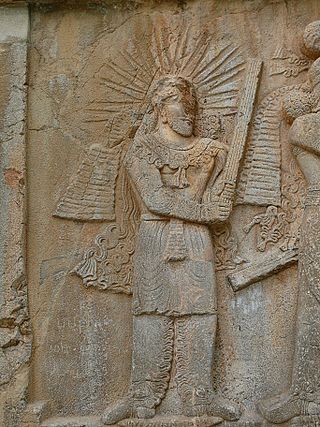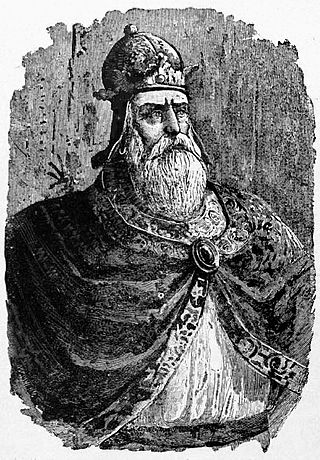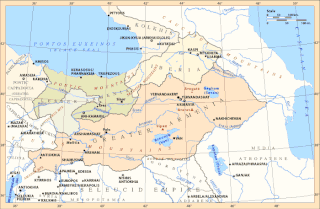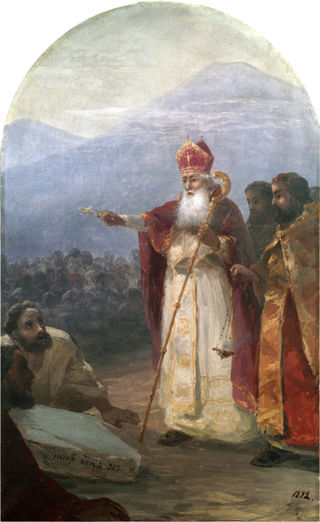
Hormizd-Ardashir, better known by his dynastic name of Hormizd I, was the third Sasanian King of Kings (shahanshah) of Iran, who ruled from May 270 to June 271. He was the third-born son of Shapur I, under whom he was governor-king of Armenia, and also took part in his father's wars against the Roman Empire. Hormizd I's brief time as ruler of Iran was largely uneventful. He built the city of Hormizd-Ardashir, which remains a major city today in Iran. He promoted the Zoroastrian priest Kartir to the rank of chief priest (mowbed) and gave the Manichaean prophet Mani permission to continue his preaching.

Hormizd III, was the seventeenth king (shah) of the Sasanian Empire, ruling briefly from 457 to 459. He was the son and successor of Yazdegerd II. His reign was marked by the rebellion of his younger brother Peroz I, who with the aid of one of the Seven Great Houses of Iran, the House of Mihran, and the eastern neighbours of the Sasanians, the Hephthalites, had him captured and executed.

Bahram I was the fourth Sasanian King of Kings of Iran from 271 to 274. He was the eldest son of Shapur I and succeeded his brother Hormizd I, who had reigned for a year.

Bahram IV, was the Sasanian King of Kings of Iran from 388 to 399. He was likely the son and successor of Shapur III.

Shapur III, was the Sasanian King of Kings of Iran from 383 to 388. He was the son of Shapur II and succeeded his uncle Ardashir II.

Arsaces I was the first king of Parthia, ruling from 247 BC to 217 BC, as well as the founder and eponym of the Arsacid dynasty of Parthia. The leader of the Parni, one of the three tribes of the Dahae confederacy, Arsaces founded his dynasty in the mid-3rd century BC when he conquered the satrapy of Parthia from Andragoras, who had rebelled against the Seleucid Empire. He spent the rest of his reign consolidating his rule in the region, and successfully stopped the Seleucid efforts to reconquer Parthia. Due to Arsaces' achievements, he became a popular figure amongst the Arsacid monarchs, who used his name as a royal honorific. By the time of his death, Arsaces had laid the foundations of a strong state, which would eventually transform into an empire under his great-grandnephew, Mithridates I, who assumed the ancient Near Eastern royal title of King of Kings. Arsaces was succeeded by his son Arsaces II.

Mithra, commonly known as Mehr or Mithras among Romans, is an ancient Iranian deity of covenants, light, oath, justice, the sun, contracts, and friendship. In addition to being the divinity of contracts, Mithra is also a judicial figure, an all-seeing protector of Truth, and the guardian of cattle, the harvest, and the Waters.

Vologases I was the King of Kings of the Parthian Empire from 51 to 78. He was the son and successor of Vonones II. He was succeeded by his younger son Pacorus II, who continued his policies.

Tiridates III, also known as Tiridates the Great or Tiridates IV, was the Armenian Arsacid king from c. 298 to c. 330. In the early 4th century, Tiridates proclaimed Christianity as the state religion of Armenia, making the Armenian kingdom the first state to officially embrace Christianity.

Vologases V was King of Kings of the Parthian Empire from 191 to 208. As king of Armenia, he is known as Vologases II. Not much is known about his period of kingship of Armenia, except that he put his son Rev I on the Iberian throne in 189. Vologases succeeded his father Vologases IV as king of the Parthian Empire in 191; it is uncertain if the transition of power was peaceful or if Vologases took the throne in a civil war. When Vologases acceded the Parthian throne, he passed the Armenian throne to his son Khosrov I.

Yazata is the Avestan word for a Zoroastrian concept with a wide range of meanings but generally signifying a divinity. The term literally means "worthy of worship or veneration", and is thus, in this more general sense, also applied to certain healing plants, primordial creatures, the fravashis of the dead, and to certain prayers that are themselves considered holy. The yazatas collectively are "the good powers under Ahura Mazda", who is "the greatest of the yazatas".
The Arsacid dynasty, called the Arshakuni in Armenian, ruled the Kingdom of Armenia, with some interruptions, from 12 to 428. The dynasty was a branch of the Arsacid dynasty of Parthia. Arsacid kings reigned intermittently throughout the chaotic years following the fall of the Artaxiad dynasty until 62, when Tiridates I, brother of Parthian King Vologases I, secured Arsacid rule in Armenia as a client king of Rome. However, he did not succeed in establishing his line on the throne, and various princes of different Arsacid lineages ruled until the accession of Vologases II, who succeeded in establishing his own line on the Armenian throne, which ruled the kingdom until its abolishment by the Sasanian Empire in 428.

The Satrapy of Armenia, a region controlled by the Orontid dynasty, was one of the satrapies of the Achaemenid Empire in the 6th century BC that later became an independent kingdom. Its capitals were Tushpa and later Erebuni.
House of Suren or Surenas is one of two Parthian noble families explicitly mentioned by name in sources dateable to the Arsacid period.

Khvarenah (also spelled khwarenah or xwarra(h): Avestan: 𐬓𐬀𐬭𐬆𐬥𐬀𐬵 xᵛarənah) is an Avestan word for a Zoroastrian concept literally denoting "glory" or "splendour" but understood as a divine mystical force or power projected upon and aiding the appointed. The neuter noun thus also connotes "(divine) royal glory", reflecting the perceived divine empowerment of kings. The term also carries a secondary meaning of "(good) fortune"; those who possess it are able to complete their mission or function.

Anahita is the Old Persian form of the name of an Iranian goddess and appears in complete and earlier form as Aredvi Sura Anahita, the Avestan name of an Indo-Iranian cosmological figure venerated as the divinity of "the Waters" (Aban) and hence associated with fertility, healing and wisdom. There is also a temple named Anahita in Iran. Aredvi Sura Anahita is Ardwisur Anahid or Nahid (ناهید) in Middle and Modern Persian, and Anahit in Armenian. An iconic shrine cult of Aredvi Sura Anahita was, together with other shrine cults, "introduced apparently in the 4th century BCE and lasted until it was suppressed in the wake of an iconoclastic movement under the Sassanids." The symbol of goddess Anahita is the Lotus flower. Lotus Festival is an Iranian festival that is held on the end of the first week of July. Holding this festival at this time was probably based on the blooming of lotus flowers at the beginning of summer.

Christianity first spread to Armenia prior to the official adoption of the faith in the early fourth century, although the details are obscure. In the early fourth century, the Kingdom of Greater Armenia adopted Christianity as its state religion, becoming the first state to do so. The Arsacid king of Armenia at the time, Trdat, was converted by Gregory the Illuminator, who became the first head of the Armenian Church. The traditional date for the conversion of Armenia is 301, although many alternative dates have been proposed by scholars. While Armenia's church structure was established at this time, it took longer for Christianity to fully take root in the country. The greatest progress came after the invention of the Armenian alphabet by Mesrop Mashtots and the translation of the Bible and liturgy into Armenian in the fifth century.

Khosrov II, also known as Khosrov the Brave was an Armenian king from the Arsacid dynasty in the mid-third century.

Anak the Parthian was a Parthian noble who, according to the Armenian tradition, was the father of Gregory the Illuminator, who converted Armenia to Christianity in the early fourth century. Anak is said to have killed King Khosrov of Armenia at the incitement of the Sasanians, leading to his own murder and the extermination of his family, except for the child Gregory, who was saved and taken to Roman territory. The details and historicity of this account have been debated by historians.

Adurbadagan was a Sasanian province located in northern Iran, almost corresponded to the present-day Iranian Azerbaijan. Governed by a marzban ("margrave"), it functioned as an important frontier region against the neighbouring country of Armenia.

















